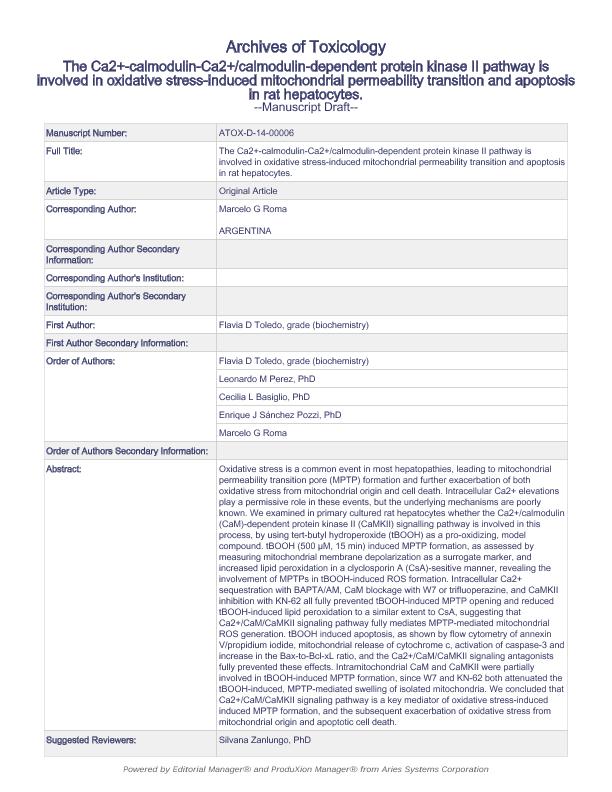Artículo
The Ca2+-calmodulin-Ca2+/calmodulin- dependent protein kinase II signaling pathway is involved in oxidative stress-induced mitochondrial permeability transition and apoptosis in isolated rat hepatocytes
Toledo, Flavia Daniela ; Perez, Leonardo Martin
; Perez, Leonardo Martin ; Basiglio, Cecilia Lorena
; Basiglio, Cecilia Lorena ; Ochoa, Justina Elena
; Ochoa, Justina Elena ; Sanchez Pozzi, Enrique Juan
; Sanchez Pozzi, Enrique Juan ; Roma, Marcelo Gabriel
; Roma, Marcelo Gabriel
 ; Perez, Leonardo Martin
; Perez, Leonardo Martin ; Basiglio, Cecilia Lorena
; Basiglio, Cecilia Lorena ; Ochoa, Justina Elena
; Ochoa, Justina Elena ; Sanchez Pozzi, Enrique Juan
; Sanchez Pozzi, Enrique Juan ; Roma, Marcelo Gabriel
; Roma, Marcelo Gabriel
Fecha de publicación:
03/2014
Editorial:
Springer
Revista:
Archives of Toxicology
ISSN:
0340-5761
Idioma:
Inglés
Tipo de recurso:
Artículo publicado
Clasificación temática:
Resumen
Oxidative stress (OS) is a common event in most hepatopathies, leading to mitochondrial permeability transition pore (MPTP) formation and further exacerbation of both OS from mitochondrial origin and cell death. Intracellular Ca2+ increase plays a permissive role in these events, but the underlying mechanisms are poorly known. We examined in primary cultured rat hepatocytes whether the Ca2+/calmodulin (CaM)-dependent protein kinase II (CaMKII) signaling pathway is involved in this process, by using tert-butyl hydroperoxide (tBOOH) as a pro-oxidant, model compound. tBOOH (500 μM, 15 min) induced MPTP formation, as assessed by measuring mitochondrial membrane depolarization as a surrogate marker, and increased lipid peroxidation in a cyclosporin A (CsA)-sensitive manner, revealing the involvement of MPTPs in tBOOH-induced radical oxygen species (ROS) formation. Intracellular Ca2+ sequestration with BAPTA/AM, CaM blockage with W7 or trifluoperazine, and CaMKII inhibition with KN-62 all fully prevented tBOOH-induced MPTP opening and reduced tBOOH-induced lipid peroxidation to a similar extent to CsA, suggesting that Ca2+/CaM/CaMKII signaling pathway fully mediates MPTP-mediated mitochondrial ROS generation. tBOOH-induced apoptosis, as shown by flow cytometry of annexin V/propidium iodide, mitochondrial release of cytochrome c, activation of caspase-3 and increase in the Bax-to-Bcl-xL ratio, and the Ca2+/CaM/CaMKII signaling antagonists fully prevented these effects. Intramitochondrial CaM and CaMKII were partially involved in tBOOH-induced MPTP formation, since W7 and KN-62 both attenuated the tBOOH-induced, MPTP-mediated swelling of isolated mitochondria. We concluded that Ca2+/CaM/CaMKII signaling pathway is a key mediator of OS-induced MPTP formation and the subsequent exacerbation of OS from mitochondrial origin and apoptotic cell death.
Archivos asociados
Licencia
Identificadores
Colecciones
Articulos(IFISE)
Articulos de INST.DE FISIOLOGIA EXPERIMENTAL (I)
Articulos de INST.DE FISIOLOGIA EXPERIMENTAL (I)
Citación
Toledo, Flavia Daniela; Perez, Leonardo Martin; Basiglio, Cecilia Lorena; Ochoa, Justina Elena; Sanchez Pozzi, Enrique Juan; et al.; The Ca2+-calmodulin-Ca2+/calmodulin- dependent protein kinase II signaling pathway is involved in oxidative stress-induced mitochondrial permeability transition and apoptosis in isolated rat hepatocytes; Springer; Archives of Toxicology; 88; 9; 3-2014; 1695-1709
Compartir
Altmétricas



